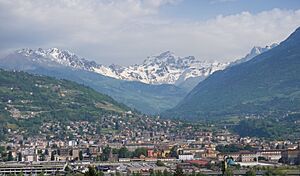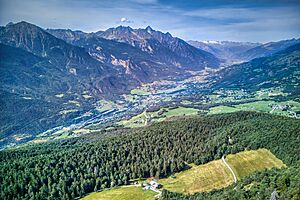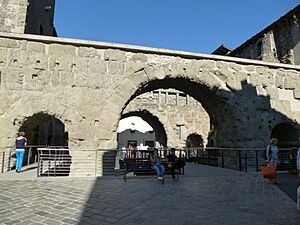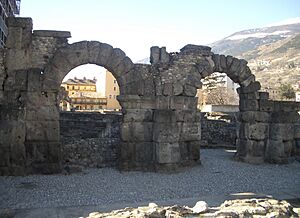Aosta facts for kids
Quick facts for kids
Aosta
|
|||
|---|---|---|---|
| Città di Aosta Ville d'Aoste |
|||

Aerial view of Aosta
|
|||
|
|||
| Country | Italy | ||
| Region | Aosta Valley | ||
| Frazioni | Arpuilles, Beauregard, Bibian, Bioulaz, Borgnalle, Brenloz, Busséyaz, Cache, La Combe, Les Capucins, Chabloz, Champailler, Collignon, Cossan, Cotreau, Duvet, Entrebin, Excenex, Les Fourches, Laravoire, Montfleury, Movisod, Pallin, Papet, Pléod, Porossan, La Riondaz, La Rochère, Roppoz, Saraillon, Saumont, Seyssinod, Signayes, Talapé, Tsanté, Tzambarlet, Vignole | ||
| Area | |||
| • Total | 21.37 km2 (8.25 sq mi) | ||
| Elevation | 583 m (1,913 ft) | ||
| Population
(31 December 2022)
|
|||
| • Total | 33,093 | ||
| • Density | 1,548.6/km2 (4,010.8/sq mi) | ||
| Time zone | UTC+1 (CET) | ||
| • Summer (DST) | UTC+2 (CEST) | ||
| Postal code |
11100
|
||
| Dialing code | 0165 | ||
| Patron saint | St. Gratus | ||
| Saint day | September 7 | ||
Aosta is a cool city in the Aosta Valley region of Italy. It's located high up in the Alps, about 110 kilometers (68 miles) northwest of Turin. Aosta is special because it's a bilingual region, meaning people speak both Italian and French. The city sits where two rivers, the Buthier and the Dora Baltea, meet. It's also close to important mountain tunnels like the Mont Blanc Tunnel and the Great St Bernard Tunnel, making it a key spot for travel through the mountains.
Contents
Aosta's Ancient History
Aosta has a very long history, going back to ancient times. It was first settled by a group of people called the Salassi. Around 25 BC, the Romans took control of the area. A Roman leader named Terentius Varro founded a Roman colony here called Augusta Praetoria Salassorum. This new city was home to 3,000 retired Roman soldiers.
Because of its location where two rivers met and near important mountain passes, Aosta was very important for the Roman Empire. It was designed like a Roman military camp, which helped protect the area.
From Roman Times to Today
After the Western Roman Empire fell, Aosta was ruled by different groups, including the Burgundians, Ostrogoths, and Byzantines. Later, the Lombards took over, but they were defeated by the Frankish Empire under Pepin the Short.
Under Pepin's son, Charlemagne, Aosta became an important stop on the Via Francigena, a famous road that led from Aachen (in modern-day Germany) to Italy. This made Aosta a key place for travelers and trade. In the 10th century, Aosta became part of the Kingdom of Burgundy. Later, it joined the lands of Count Humbert I of Savoy.
The people of Aosta were given the right to hold their own assembly in 1189. This assembly helped govern the city for many centuries.
Aosta's Climate and Weather
Aosta is in a unique spot in the mountains, which affects its weather. It's on the side of the Mont Blanc massif that gets less rain, like a "rain shadow." This means it has a fairly dry climate.
The city has cool to very cold winters and hot summers. Even though it's in the mountains, it doesn't get a huge amount of rain throughout the year.
| Climate data for Aosta (1991–2020 normals), 547 m asl, extremes since 1984 | |||||||||||||
|---|---|---|---|---|---|---|---|---|---|---|---|---|---|
| Month | Jan | Feb | Mar | Apr | May | Jun | Jul | Aug | Sep | Oct | Nov | Dec | Year |
| Record high °C (°F) | 22.9 (73.2) |
26.0 (78.8) |
26.3 (79.3) |
29.3 (84.7) |
32.2 (90.0) |
40.4 (104.7) |
36.5 (97.7) |
38.0 (100.4) |
34.0 (93.2) |
32.0 (89.6) |
23.0 (73.4) |
21.7 (71.1) |
40.4 (104.7) |
| Mean daily maximum °C (°F) | 6.2 (43.2) |
10.0 (50.0) |
14.6 (58.3) |
18.1 (64.6) |
21.5 (70.7) |
25.1 (77.2) |
28.8 (83.8) |
28.1 (82.6) |
23.1 (73.6) |
17.6 (63.7) |
11.5 (52.7) |
5.1 (41.2) |
18.3 (64.9) |
| Daily mean °C (°F) | 1.5 (34.7) |
4.2 (39.6) |
8.4 (47.1) |
11.6 (52.9) |
15.8 (60.4) |
19.2 (66.6) |
22.2 (72.0) |
21.5 (70.7) |
17.5 (63.5) |
12.2 (54.0) |
6.4 (43.5) |
0.8 (33.4) |
11.7 (53.1) |
| Mean daily minimum °C (°F) | −3.2 (26.2) |
−1.7 (28.9) |
2.2 (36.0) |
5.3 (41.5) |
9.7 (49.5) |
13.3 (55.9) |
15.5 (59.9) |
14.9 (58.8) |
11.7 (53.1) |
6.8 (44.2) |
1.4 (34.5) |
−3.4 (25.9) |
6.0 (42.8) |
| Record low °C (°F) | −17.6 (0.3) |
−15.0 (5.0) |
−15.9 (3.4) |
−8.6 (16.5) |
−3.8 (25.2) |
4.0 (39.2) |
7.0 (44.6) |
6.2 (43.2) |
−3.7 (25.3) |
−12.6 (9.3) |
−14.1 (6.6) |
−18.1 (−0.6) |
−18.1 (−0.6) |
| Average precipitation mm (inches) | 33.1 (1.30) |
19.1 (0.75) |
37.3 (1.47) |
28.9 (1.14) |
48.9 (1.93) |
41.2 (1.62) |
27.9 (1.10) |
27.2 (1.07) |
27.0 (1.06) |
42.8 (1.69) |
52.9 (2.08) |
28.0 (1.10) |
414.3 (16.31) |
| Average precipitation days (≥ 1 mm) | 4.1 | 3.9 | 4.7 | 4.5 | 7.4 | 7.3 | 5.5 | 5.1 | 4.1 | 5.3 | 4.9 | 5.0 | 61.8 |
| Source: Météo Climat | |||||||||||||
Population of Aosta
| Historical population | |||||||||||||||||||||||||||||||||||||||||||||||||||||||
|---|---|---|---|---|---|---|---|---|---|---|---|---|---|---|---|---|---|---|---|---|---|---|---|---|---|---|---|---|---|---|---|---|---|---|---|---|---|---|---|---|---|---|---|---|---|---|---|---|---|---|---|---|---|---|---|
|
|
||||||||||||||||||||||||||||||||||||||||||||||||||||||
| Source: ISTAT | |||||||||||||||||||||||||||||||||||||||||||||||||||||||
Aosta has been home to many people over the centuries. In 1861, about 8,231 people lived there. The population grew steadily, reaching its highest point in 1981 with over 37,000 residents. As of December 31, 2022, the city had a population of 33,093 people.
Exploring Aosta's Main Sights
Aosta is like an open-air museum, with many ancient Roman buildings still standing.
Ancient Roman Walls and Gates
The old town walls of Aosta are still mostly complete. They form a large rectangle around the city. These walls are about 6.4 meters (21 feet) high and were built very strong. There were originally 20 towers along the walls, with two at each of the four main gates.
Some of these towers are still well-preserved today:
- Tour du Lépreux (Leper's Tower): This tower got its name from a leper who was held there in the late 1600s. A famous novel was even written about him.
- Tourneuve (13th century).
- Tower of Bramafan: Built in the 11th century, this tower was once home to important local leaders. Its name means "to scream for hunger" in the local language.
The south and east gates of the city are still standing. The eastern gate, called the Porta Praetoria, is especially impressive. It was built in the 1st century AD and still looks much like it did back then, with two sets of arches.
Roman Theatre and Other Structures
The Roman theatre is another amazing sight. Part of its southern wall, which is 22 meters (72 feet) tall, is still visible. This huge theater could hold up to 4,000 people! Near the theater, there was also an amphitheater for gladiator fights and other shows.
Archaeologists have also found remains of a marketplace, storehouses, and temples, showing how busy and important Aosta was in Roman times.
Outside the City Walls
Just outside the city walls, you can see the Arch of Augustus. This grand arch was built in 35 BC to celebrate a Roman victory over the Salassi people. About 8 kilometers (5 miles) west of Aosta is the Pont d'Aël, a Roman bridge with a single arch. It even has a covered walkway for people to use in winter!
Other Important Sights
- Saint-Martin-de-Corléans Megalithic Area: This ancient site has artifacts and tombs from the Neolithic era, showing human activity from thousands of years ago.
- Aosta Cathedral: The main church of Aosta, built in the 4th century and rebuilt in the 11th century.
- Collegiate church of Saint Ursus: A beautiful church with a peaceful cloister (a covered walkway around a courtyard).
- Bridge of Grand Arvou: A medieval bridge that also served as an aqueduct, carrying water.
Getting Around Aosta
Aosta is a key point for travel through the Alps. Two major roads meet here:
- National Road 26: Connects Aosta to Chivasso and the Little St Bernard Pass, leading towards France.
- National Road 27: Connects Aosta to the Great St Bernard Pass, leading towards Switzerland.
The city is also served by the A5 motorway, which links Turin to Courmayeur.
Train and Bus Travel
The Aosta railway station opened in 1886. You can take direct trains from Aosta to Ivrea. There's also a main bus station near the train station. Buses connect Aosta to nearby valleys and other cities like Turin, Milan, Chamonix (France), and Martigny (Switzerland).
Aosta Airport
Aosta also has its own airport, located about 5 kilometers (3 miles) east of the city.
Famous People from Aosta
Aosta has been home to several notable individuals:
- Anselm of Aosta (1033–1109): He became the Archbishop of Canterbury, a very important religious leader in England.
- Xavier de Maistre (1763–1852): A writer famous for his novel Le lépreux de la cité d'Aoste (The leper from Aosta).
- Innocenzo Manzetti (1826–1877): An Italian inventor who was born in Aosta.
Sister Cities of Aosta
Aosta is "twinned" with several cities around the world. This means they have special friendly relationships and often share cultural exchanges.
 Chamonix-Mont-Blanc, France
Chamonix-Mont-Blanc, France Kaolack, Senegal
Kaolack, Senegal Martigny, Switzerland
Martigny, Switzerland Narbonne, France
Narbonne, France Sinaia, Romania
Sinaia, Romania
See also
 In Spanish: Aosta para niños
In Spanish: Aosta para niños







